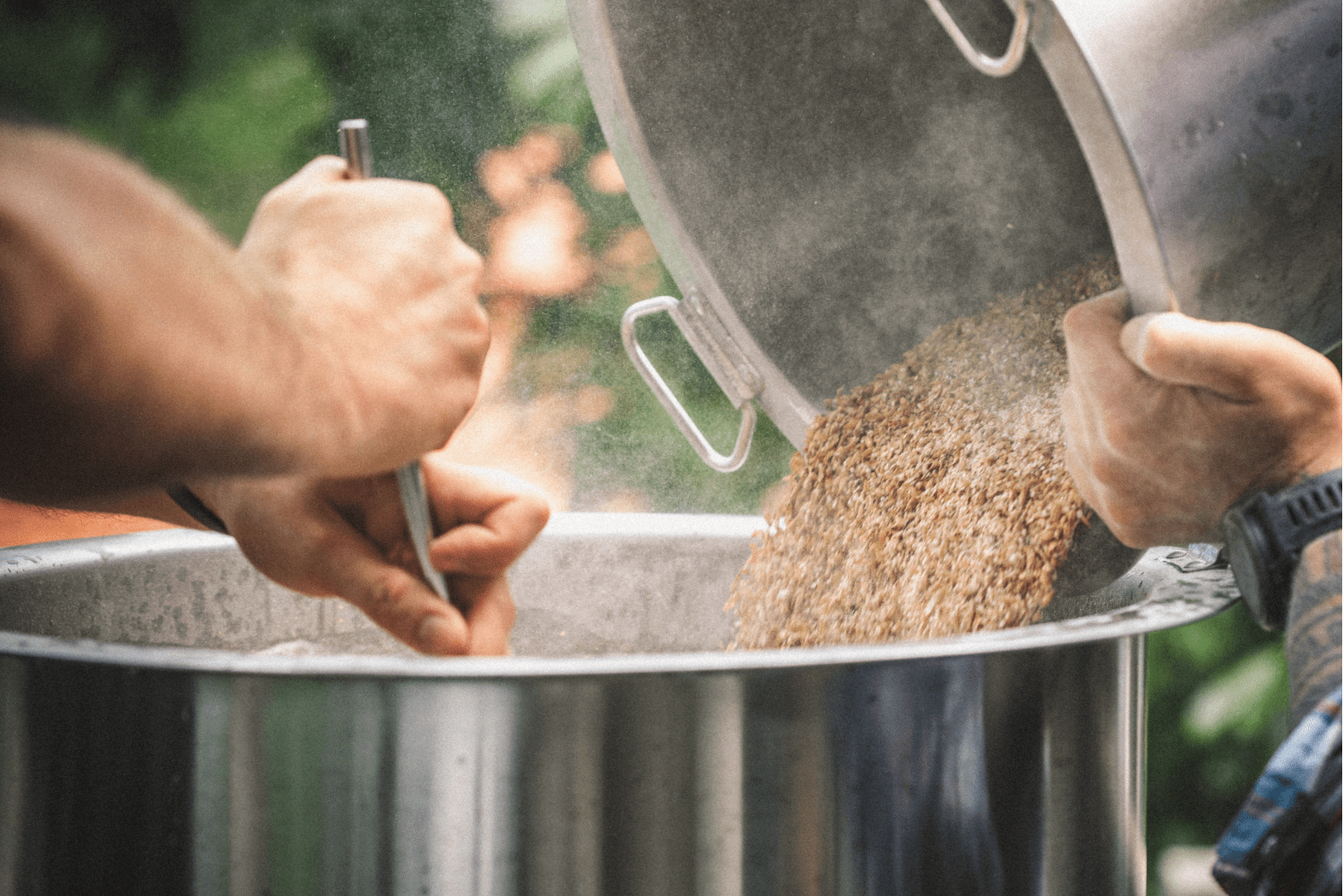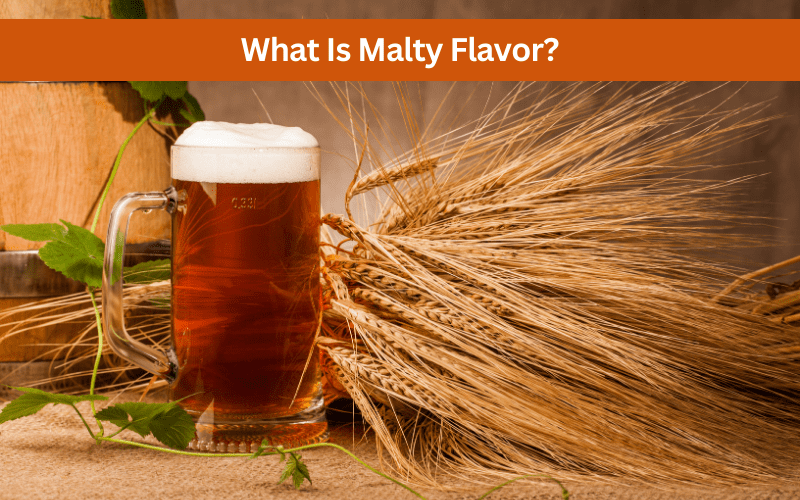Picture this: you take a sip of a dark, velvety brew, and instantly, your taste buds are captivated by a symphony of flavors. Amidst the rich and complex notes dancing on your palate, one element stands out—malty flavor. It’s a sensation that evokes memories of cozy evenings by the fireplace, warm homemade bread fresh out of the oven, and the comforting embrace of comfort food. But what is malty flavor? As a lover of all things culinary, I embarked on a journey to unravel the secrets of this captivating taste, diving deep into its origins, chemistry, and diverse applications. Join me as we unlock what is malty flavorr, and discover the hidden depths of richness that lie within.
What is Malt Flavor?
What is malty flavor? It is a rich, nutty, and toasty taste derived from the process of malting grains, such as barley. The malting process involves germinating and kilning grains, resulting in complex flavors that enhance beverages like beer and foods like bread.

What is Malt Extract?
Malt extract is a concentrated sweet syrup or powder derived from malted grains, typically barley. It is made by mashing malted grains to extract the sugars, then evaporating the liquid to create a dense extract. Used in brewing, baking, and cooking, malt extract adds flavor, color, and sweetness to a variety of recipes.
What is Malt Flavor Made of?
What is malty flavor made of? Malt flavor is made up of a combination of compounds that contribute to its unique taste profile. Here are the key components:
Maillard reaction products
During the malting process, amino acids and reducing sugars react to create Maillard reaction products. These compounds contribute to the desirable toasty and caramelized flavors found in malt.
Melanoidins
These brown pigments are formed during the kilning stage of malting and contribute to the color and flavor of malt. They add depth and richness, providing notes of bread crust, roasted nuts, and coffee.
Diacetyl
Diacetyl is a natural byproduct of fermentation in malt-based beverages. In small amounts, it imparts a buttery or butterscotch-like flavor that is characteristic of certain beer styles.
Phenols
Some malt varieties contain phenolic compounds, which can contribute smoky, spicy, or clove-like flavors. Phenols are more commonly associated with malt used in the production of certain beer styles, such as smoked beers or Belgian ales.
Enzymes
Malt contains enzymes, such as amylase and protease, which play a crucial role in breaking down starches and proteins during the mashing process in brewing. While not directly contributing to flavor, these enzymes are essential for converting complex molecules into fermentable sugars.
Volatile compounds
Various volatile compounds, including aldehydes, esters, and ketones, are produced during malting and contribute to the overall aroma and flavor profile of malt. These compounds can range from fruity and floral to nutty and biscuit-like.
It is the unique combination and interaction of these compounds that give malt its characteristic flavor, making it a versatile and sought-after ingredient in the culinary world, particularly in brewing, baking, and the creation of flavorful dishes.
Where Does Malt Flavor Come from?
Malt flavor primarily comes from malted grains, especially barley. Malted barley is produced by soaking barley in water and allowing it to germinate. During germination, enzymes in the barley convert starches into fermentable sugars.
After germination, the barley is dried in a kiln or roasted to stop the germination process and develop flavor.
The degree of drying or roasting determines the intensity and character of the malt flavor. The resulting malted barley can be further processed, such as milled or mashed, to extract sugars for fermentation or used directly in brewing and distilling.

Unraveling the Characteristics of Malty Flavor
After knowing what is malty flavor, it’s time to explore it’s characteristics. Malty flavor is a delight for the taste buds, offering a range of enticing characteristics. Understanding these unique qualities allows us to appreciate malt in all its glory:
- Richness: Malty flavor is known for its deep and full-bodied taste, providing a sense of richness to food and beverages.
- Toastiness: A toasty character is a hallmark of malt flavor, reminiscent of warm, lightly browned bread or roasted nuts.
- Nuttiness: Malt imparts a nutty undertone, adding complexity and depth to the overall flavor profile.
- Sweetness: Malt brings a natural sweetness that is not overly sugary but rather pleasantly balanced, enhancing the overall taste experience.
- Caramelized Notes: The malting process creates Maillard reaction products, resulting in caramelized flavors that contribute to the delightful complexity of malt.
- Biscuit-Like Quality: Some malt varieties exhibit a biscuit-like quality, with hints of baked goods and a pleasant crumbly texture.
- Earthiness: Certain malted grains can introduce earthy undertones, reminiscent of fresh soil or autumn leaves.
- Subtle Floral or Fruity Aromas: Depending on the malt variety and brewing technique, hints of floral or fruity aromas can be present, adding a delicate and enticing element.
- Smooth Mouthfeel: Malt can provide a smooth and velvety mouthfeel, enhancing the overall texture and satisfaction of the culinary experience.
- Balancing Element: In brewing, malt acts as a balancing element, harmonizing with other ingredients like hops to create a well-rounded and enjoyable beverage.
Understanding these characteristics allows for a deeper appreciation of the multifaceted nature of malty flavor and its potential to elevate a wide range of culinary creations.

Types of Malt
Malt is a versatile ingredient that comes in various forms, each with its own distinct characteristics and flavors. Let’s explore some of the common types of malt:
Pale malt
Also known as base malt, pale malt forms the foundation for many beer recipes. It undergoes a minimal kilning process, resulting in a light color and a mild, sweet flavor. Pale malt provides fermentable sugars and serves as a canvas for other specialty malts.
Munich malt
Munich malt undergoes a slightly longer kilning process, resulting in a richer, deeper color and a more pronounced malty flavor. It imparts a subtle toasty and bread-like character, adding complexity to beers, particularly German-style lagers and Oktoberfest brews.
Vienna malt
Similar to Munich malt, Vienna malt is kilned for a longer duration, resulting in an amber color and a smooth, malty sweetness. It is commonly used in Vienna lagers and adds a touch of biscuit-like flavor to the final product.
Crystal malt
Crystal malt, also known as caramel malt, is kilned with moist heat to promote caramelization. It ranges in color from light amber to deep red, adding sweetness, body, and a distinct caramel or toffee-like flavor to beers. Crystal malt comes in various degrees, such as 20L, 40L, or 60L, indicating the color intensity and sweetness level.
Chocolate malt
Chocolate malt is kilned at higher temperatures, resulting in a dark brown to black color and a roasted flavor profile. It imparts a subtle chocolate or coffee-like taste and is commonly used in stouts, porters, and darker beers to enhance their color and provide a touch of bitterness.
Roasted barley
Roasted barley is the darkest of the malt varieties, almost black in color. It undergoes intense kilning, resulting in a robust, roasted, and coffee-like flavor. Roasted barley is used in stouts, porters, and other dark beers to provide intense color, dryness, and a distinct bitterness.
Wheat malt
Wheat malt is made from malted wheat grains and contributes a light, delicate, and slightly tangy flavor to beers. It adds a smooth mouthfeel, enhanced head retention, and is commonly used in wheat beers, hefeweizens, and Belgian-style ales.

What is a Malty Beer?
So, what is malty beer? A malty beer refers to a beer style that prominently showcases the flavors and characteristics of malted grains, particularly barley.
It is characterized by a rich, sweet, and sometimes toasty flavor profile derived from the malt. Malty beers often have a fuller body and a smooth mouthfeel, with a malt-forward balance compared to other beer styles.
They can range from lighter, refreshing options like Munich Helles and Scottish Ales to heavier, more robust styles like Bock or English Barleywine.
The maltiness in these beers can exhibit notes of caramel, bread, nuts, or even chocolate, providing a satisfying and flavorful drinking experience.
How to Identify Malt Flavor in Beer
Identifying malt flavor in beer requires attentive observation of various sensory cues. Here’s how to discern and appreciate malt flavors in beer:
- Color: Malt contributes to the beer’s color. Beers with a deeper amber, copper, or brown hue often indicate a stronger malt presence compared to lighter-colored beers.
- Aroma: Malt imparts specific aromas. Take note of the beer’s aroma, looking for hints of toasted grains, caramel, toffee, bread, or even chocolate. These are indicative of malt influence.
- Taste: Malt flavor can be detected on the palate. Pay attention to the beer’s sweetness, which is often attributed to the malt. Look for flavors like caramel, biscuit, nuttiness, or a gentle roastiness that indicates the presence of malt.
- Mouthfeel: Malt affects the mouthfeel of beer. A fuller, rounder, or slightly chewy body can suggest a stronger malt character. Malt contributes to the perceived texture and weight of the beer on the tongue.
- Balance: Consider the balance between malt and other flavors. Malt-forward beers will have a more prominent malt character, while beers with a well-balanced profile will showcase a harmonious interplay between malt and hop bitterness.
- Style guidelines: Familiarize yourself with specific beer styles that are known for their malt-forward characteristics. Styles like Scottish Ale, Märzen, or English Mild are examples of beers where malt flavors take center stage.
By engaging your senses and paying attention to these factors, you can better identify and appreciate the distinct malt flavor in beer. Enjoy the journey of exploring the nuances and complexities that malt brings to your beer-drinking experience.

Some Malty Flavor Beers
Here are a few examples of beer styles known for their malty flavor profiles:
- Märzen/Oktoberfest: Originating from Germany, Märzen and Oktoberfest beers are known for their rich maltiness. They offer a toasty, bready, and slightly sweet flavor, with a medium body and a clean finish.
- Scotch Ale/Wee Heavy: Scottish Ales, particularly the strong Scotch Ale or Wee Heavy style, exhibit a pronounced malt character. They boast caramel, toffee, and sometimes even smoky flavors, with a full-bodied and robust profile.
- Bock: Bock beers, originating from Germany, feature a strong malt backbone. They provide a rich, malty sweetness with notes of bread crust, nuts, and sometimes a hint of chocolate. Bocks are typically stronger and fuller-bodied lagers.
- English Barleywine: English Barleywine is a strong ale that showcases a complex malt profile. It offers intense flavors of toffee, caramel, and dark fruits, with a deep malt sweetness and a warming alcohol presence.
- Amber Ale: Amber Ales display a balance between malt and hops, but still emphasize malt flavors. They deliver a moderate caramel and biscuit character with a medium body, providing a smooth and malty drinking experience.
- Irish Red Ale: Irish Red Ales feature a pleasant malt presence. They offer a moderate sweetness, with flavors of toasted grains, toffee, and a slight roasted note. These beers have a smooth and dry finish.
Remember, these are just a few examples, and there are many other beer styles that exhibit varying degrees of malty flavors. Exploring different styles will allow you to discover the breadth and depth of malty goodness in the world of beer.
Some Malt Heavy Beers
Here are a few examples of malt-heavy beers that showcase a prominent malt character:
- English Brown Ale: English Brown Ales are known for their malt-forward profiles. They offer a combination of toasty, nutty, and caramel flavors, with a medium body and a balanced bitterness.
- Doppelbock: Doppelbock, a strong German lager, is characterized by a rich maltiness. It showcases deep caramel and dark fruit flavors, with a full body and a slightly sweet finish.
- English Old Ale: English Old Ales are malt-driven beers with a complex flavor profile. They typically exhibit deep malt flavors of toffee, molasses, and dark fruits, with a medium to full body and a warming character.
- English Mild: English Mild ales focus on malt character while maintaining lower alcohol levels. They feature a range of malt flavors, including toasted bread, biscuit, and subtle caramel notes, with a light to medium body.
- Belgian Dubbel: Belgian Dubbels are known for their rich maltiness combined with Belgian yeast character. They offer flavors of caramel, dark fruit, and hints of spice, with a medium body and a touch of sweetness.
- Scotch Ale/Wee Heavy (stronger versions): Alongside the regular Scotch Ale, stronger versions of this style, sometimes referred to as Wee Heavy, provide an even more pronounced malt presence. They exhibit a deep malt complexity, often showcasing toffee, caramel, and dark fruit flavors.
These malt-heavy beers will indulge your taste buds with their robust malt profiles and offer a delightful drinking experience.

How to Make a Beer More Malty?
If you’re looking to enhance the malty character of your beer, here are some techniques to consider:
- Adjust the Grain Bill: Increase the proportion of malted grains in your recipe, particularly those known for their malty flavors, such as Munich malt, Vienna malt, or specialty caramel malts. This will elevate the maltiness in your beer.
- Extend the Mash Time: Prolonging the mash time allows for more enzymatic activity, leading to higher sugar extraction from the grains. This can result in a fuller-bodied beer with a richer malt profile.
- Increase Mash Temperature: Raising the mash temperature within the appropriate range (around 150-156°F or 66-69°C) can encourage the extraction of more unfermentable sugars, leading to increased sweetness and body in the finished beer.
- Incorporate Specialty Malts: Include specialty malts like caramel or roasted malts to add specific malt flavors to your beer. Experiment with different types and quantities to achieve the desired malt profile.
- Adjust Hop Bitterness: While hops provide balance in beer, reducing hop bitterness can allow the malt flavors to shine. Consider selecting hop varieties with lower alpha acid content or adjusting the hop additions to avoid overwhelming the malt character.
- Fermentation Temperature: Opt for a fermentation temperature that promotes the desired malt flavors. Cooler fermentation temperatures (within the yeast’s recommended range) can help retain malt sweetness and complexity.
- Consider Yeast Selection: Different yeast strains can impact the perception of maltiness in beer. Some yeast strains may accentuate malt flavors, while others can enhance fruity or spicy characteristics. Choose a yeast strain that complements and supports the malt profile you desire.
- Aging: Allowing your beer to undergo a period of aging, whether in the fermenter or bottle, can further develop malt flavors. This aging process allows the flavors to mellow, harmonize, and become more pronounced.

Health Benefits of Malt
Malt offers several health benefits due to its nutrient content and unique properties. Here are some of the potential health benefits associated with malt:
- Nutritional value: Malt is a rich source of vitamins, minerals, and antioxidants. It contains essential nutrients like B vitamins (including folate, niacin, and riboflavin), minerals (such as magnesium, manganese, and selenium), and dietary fiber, contributing to overall nutritional well-being.
- Digestive health: The dietary fiber found in malt can promote healthy digestion. Fiber helps regulate bowel movements, prevents constipation, and supports a healthy gut microbiome.
- Energy boost: Malt is a concentrated source of carbohydrates, providing quick and sustained energy. It can be beneficial for athletes, individuals with high energy demands, or those looking for a natural energy boost.
- Nutrient absorption: Malt contains enzymes that aid in breaking down complex molecules into more readily absorbable forms. This can enhance the absorption of essential nutrients from other foods consumed alongside malt-containing products.
- Blood sugar regulation: Malt has a lower glycemic index compared to refined sugars, meaning it releases glucose into the bloodstream at a slower and steadier rate. This can help maintain stable blood sugar levels and may be advantageous for individuals with diabetes or those seeking to manage their blood sugar levels.
- Antioxidant properties: Malt contains antioxidants that help combat harmful free radicals in the body. These antioxidants, such as phenolic compounds and Maillard reaction products, contribute to the overall health-promoting properties of malt.
- Bone health: Malt contains minerals like magnesium and manganese, which are essential for maintaining healthy bones and teeth. These minerals contribute to bone strength, density, and overall skeletal health.
The health benefits of malt are based on its natural properties and nutritional composition. However, individual needs and circumstances may vary, so it’s always advisable to consult with a healthcare professional or nutritionist for personalized advice and guidance.
FAQs
Can malt be enjoyed by people with diabetes?
People with diabetes should consume malt in moderation due to its high carbohydrate content, which can affect blood sugar levels. It’s important to consult a healthcare professional for personalized guidance on incorporating malt into a diabetic diet.
Is malt only used in brewing beer?
No, malt has a wide range of applications beyond brewing. It is also used in baking, confectionery, distilling spirits like whisky, and as a flavoring ingredient in various foods and beverages.
Are there any famous malt-based dishes from specific regions?
Yes, several regions have traditional dishes that incorporate malt. Examples include Scottish shortbread, English malt loaf, Danish malt bread, and Maltese honey rings.
Are there any gluten-free malt alternatives?
Yes, there are gluten-free malt alternatives available. These are typically made from gluten-free grains like sorghum, rice, or millet and can be used to achieve similar flavor profiles in gluten-free recipes.
How should malt-based products be stored?
Malt-based products, such as malt extract or malt powder, should be stored in a cool, dry place, preferably in a sealed container. This helps maintain their freshness and extends their shelf life.
Can malt be used in homemade brewing?
Absolutely! Malt is a key ingredient in homebrewing. It provides fermentable sugars, flavor, and color to the beer. Homebrewers can experiment with different types of malt to create unique brews.
How does malt contribute to the flavor of beer?
Malt contributes sweetness, body, and a range of flavors like caramel, toffee, bread, and even chocolate to beer. It provides a solid foundation and balances the bitterness from hops, resulting in a well-rounded beer flavor.
Can pregnant women enjoy malt?
It is generally safe for pregnant women to consume malt in moderate amounts. However, it’s always recommended to consult with a healthcare professional for personalized advice based on individual circumstances.
Is malt flavor sugar?
Malt flavor is not the same as sugar. Malt flavor is derived from the complex carbohydrates and compounds present in malted grains, whereas sugar is a simple carbohydrate.
Is malt sugar bad for you?
Malt sugar, like any other sugar, should be consumed in moderation. Excessive consumption of sugar, including malt sugar, can contribute to various health issues such as weight gain, dental problems, and increased risk of chronic diseases. It’s important to maintain a balanced and varied diet.
Conclusion
As shown above, the exploration of what is malty flavor has taken us on a captivating journey through the depths of richness and sensory delight. We have uncovered the essence of malt, delved into its origins and craftsmanship, and unraveled the chemistry behind its tantalizing flavors. From brewing to culinary applications, malt has proven to be a versatile ingredient that adds complexity and depth to a wide range of foods and beverages. Its sweet, nutty, and toasty notes create a symphony of flavors that enhance our gustatory experiences. Whether enjoyed in a malty beer, a freshly baked loaf of bread, or a glass of fine whisky, malt truly elevates the culinary landscape. So, venture forth and embrace the wonders of malt, for it is a taste that transcends borders, cultures, and cuisines, enriching our palates and tantalizing our senses. Cheers to the malty delights that await!
I’m Chen Mina, from Vol de Nuit, who has a special passion for bartending, especially mixing wine, beer, and cooktail. Here you will find content about alcoholic beverages, I will bring you knowledge that few people know about this drink.





